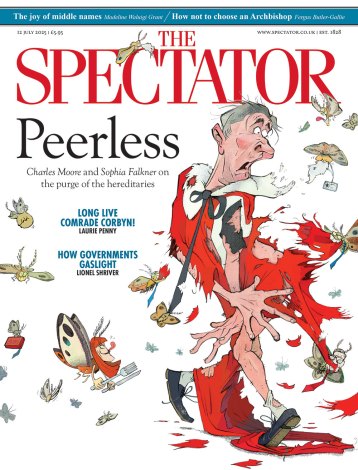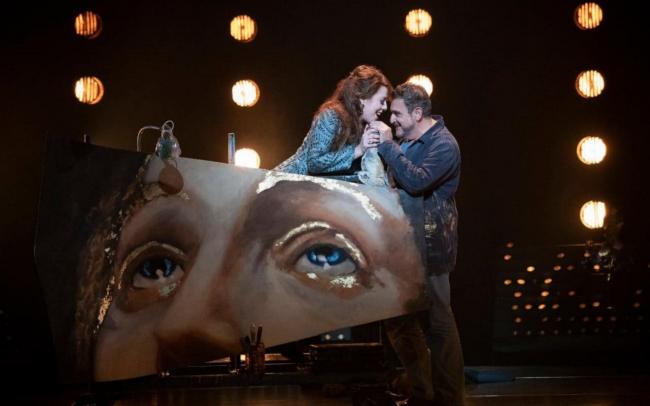At the end of Act Two of Tosca there are some 30 bars of orchestral music — accompaniment to a very specific set of stage directions. During this time Tosca takes two candles and places them on either side of the dead Scarpia’s head. She then removes a crucifix from the wall and lays it on his chest. The tableau is a messy, bloody one, but the message is clear: here the politics of religion and the religion of politics are one and the same. A pietà or the body of a thug? A murderer or a Madonna? It’s all just a matter of spin.
In a year of embattled Supreme Court nominations and moral muscle-flexing by our own DUP, Edward Dick’s new, 21st-century Tosca for Opera North relishes these slippery elisions and entanglements of church and state. A nifty piece of set design by Tom Scutt helps blur things further. As those crashing opening trombone chords come down, the stage is suddenly and blazingly illuminated to reveal the escaped Angelotti (in prisons scrubs) slithering down a rope through a Pantheon-style cupola into the church. A gilded Magdalene and votive candles speak of the spiritual, but just behind them are ranks of electric bulbs shouting something quite different. Crime scene or film set? Either way, nothing here is private, nothing is sacred. Even the climactic Mass is more political rally than act of worship, the cloying incense barely covering the sour smell of ambition.
Dick’s updating comes into its own in Act Two. No messing about here: we’re in Scarpia’s bedroom (blandly slick bachelor pad — chrome, velvet, drinks trolley). The frescoed cupola remains, watching over a properly skin-crawling game of sexual cat-and-mouse between Robert Hayward’s Scarpia (a man first, then a villain) and Giselle Allen’s Tosca. That both are mature, older — and played that way — only adds to the horrible frisson as we watch Allen go from self-assured, self-staging diva (adjusting the lighting in Act One better to frame her ‘performance’) to a foetal heap of chiffon and sequins crooning out the opening bars ‘Vissi d’arte’ as a sort of self-soothing mantra.
Cutting against the stylish visuals are performances that aren’t afraid to get a little messy. The action is propelled from the pit by Antony Hermus who drives the Opera North orchestra hard. It’s loud, it’s fast and sometimes a bit chaotic, but the effect is knife-to-your-throat compelling — a musical mugging that’ll leave you quivering.
Allen’s is not the most beautiful of sopranos, but she knows exactly what to do with it, and once you accept that this Tosca is an action-thriller and not a romantic tragedy the shrill top of the voice and clipped phrase ends make total sense. Rafael Rojas’s Cavaradossi has all the notes (his cry of ‘Vittoria!’ could stop Napoleon’s army in its tracks) but his polite romancing is obliterated by the itchy energy between Allen and Hayward, poles of revulsion and attraction locked hypnotically, irresolvably in tension.
If Tosca brings the church into the opera house, the reverse is true of Benjamin Britten’s The Burning Fiery Furnace. One of three ‘Church Parables’ the composer produced in the 1960s, fresh from his travels to the Far East (Curlew River and The Prodigal Son complete the triptych), it’s a chamber opera in church vestments — a sleek, darkly funny retelling of the story of Babylonian king Nebuchadnezzar and the three Israelites he condemns to death in the fire for refusing to worship his golden image.
Xenophobia; anti-immigration; anti-Semitism; capitalism run wild: maybe it’s Brexit (it usually is), but William Plomer’s libretto has never sounded as sharply political as it did here, elegantly staged by Jenny Ogilvie and Scottish Opera as part of the Lammermuir Festival. An abstract, contemporary setting saw Ben Johnson’s Nebuchadnezzar (catching just the right querulous, neurotic tone for this petty autocrat) become a slick-suited politico, gold pocket square placed just so, with David Stout as his cynical, smooth-talking Astrologer — a biblical spin doctor with a nice line in euphemisms. At their mercy were Benedict Nelson, William Morgan and Lancelot Nomura — sober refugees in a decadent land of wine and gold.
A curved stage held conductor Derek Clark and his eight-piece orchestra in its belly — the mysterious musical engine for the drama only released into full view for the Procession, a jangling, glittering, wordless statement of pagan excess. Colliding the contemporary naturalism of her setting with stylised, ritual direction, Ogilvie took Britten’s arm’s-length, noh-style artificiality and ran with it, cutting open the drama to show us its cogs turning.
Impeccably sung, cleverly directed, and staged on a borrowed set and minimal budget, this Burning Fiery Furnace was a masterclass in austerity opera. Because, spin it how you will, whether it’s politics, religion or art, when it comes down to it it’s all about the money.






Comments